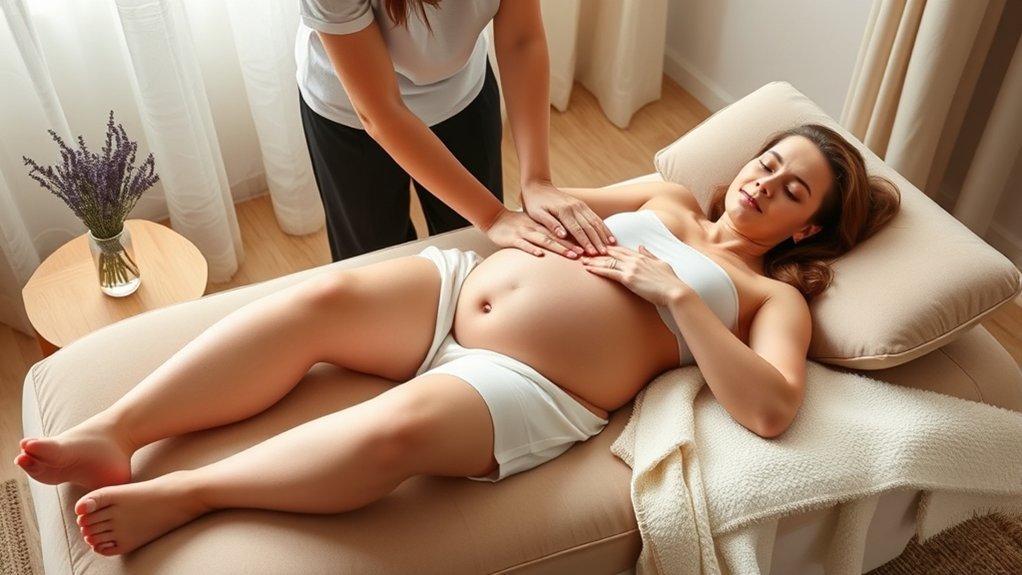Did you know that up to 80% of women experience perineal tearing during childbirth? This statistic highlights the importance of preparing the perineum for labor. One effective method to reduce this risk is through perineal massage, a technique that can enhance tissue elasticity and promote relaxation. Understanding how to perform this massage safely could make a significant difference in your birthing experience. Let’s explore the benefits and techniques involved.
What Is Perineal Massage?

Perineal massage is a technique aimed at preparing the perineum for childbirth. This practice involves gently stretching and massaging the area between the vagina and anus, aiming to enhance elasticity and reduce the risk of tearing during delivery.
Typically, you can start practicing perineal massage in the weeks leading up to your due date. It’s recommended to use a lubricant, such as oil or water-based gel, to facilitate the process. You’ll want to apply gentle pressure, gradually increasing as you become more comfortable.
This method not only familiarizes you with your body but also encourages relaxation and awareness of pelvic floor muscles. It’s advisable to consult with a healthcare provider for proper guidance and techniques suited to your individual needs.
Benefits of Perineal Massage During Pregnancy

Perineal massage during pregnancy offers significant benefits, particularly in reducing perineal trauma during delivery.
By incorporating this practice, you can enhance your overall birth experience, promoting greater comfort and potentially quicker recovery.
Understanding these advantages can help you make informed choices about your prenatal care.
Reduces Perineal Trauma
When expecting mothers incorporate perineal massage into their prenatal routine, they often experience a significant reduction in perineal trauma during childbirth. This technique helps increase elasticity in the perineal tissues, making them less prone to tearing.
By regularly practicing perineal massage, you can enhance blood flow to the area, promoting healing and flexibility. Studies indicate that women who perform this massage may have a lower incidence of episiotomies and perineal lacerations, leading to a more comfortable recovery postpartum.
Additionally, the practice encourages relaxation and can help alleviate anxiety related to childbirth. Overall, perineal massage serves as a valuable tool in preparing for delivery, helping to minimize trauma and facilitate a smoother birthing process.
Enhances Birth Experience
While preparing for childbirth, many women find that incorporating massage techniques can greatly enhance their overall birth experience.
Perineal massage, in particular, offers several benefits that positively impact labor and delivery.
- Increased Comfort: By reducing tension in the pelvic area, you may experience less discomfort during contractions.
- Improved Control: Practicing perineal massage can help you feel more in control during the pushing stage, leading to a more empowering experience.
- Enhanced Relaxation: This technique promotes relaxation, which can reduce anxiety and facilitate a smoother labor.
When to Start Perineal Massage

Starting perineal massage around the 34th week of pregnancy can be beneficial for preparing your body for labor and delivery. This timeframe allows your tissues to gradually stretch, increasing elasticity and potentially reducing the risk of tearing during childbirth.
Engaging in this practice consistently until your due date can help familiarize your body with the sensations associated with labor.
It’s important to listen to your body and consult your healthcare provider before beginning, ensuring it’s appropriate for your individual circumstances.
If you’re unsure about the timing or technique, your provider can offer guidance tailored to your needs.
How to Perform Perineal Massage Safely
To perform perineal massage safely, you need to focus on the ideal timing and proper technique.
Begin your practice during the recommended weeks and make sure you’re in a comfortable position to facilitate relaxation.
Using gentle pressure and specific movements will help you achieve the best results while minimizing discomfort.
Optimal Timing for Massage
Ideal timing for perineal massage is vital for maximizing its benefits and ensuring safety. You should start practicing perineal massage around 34 weeks of pregnancy, as this timeframe allows your body to prepare for childbirth.
Timing is significant for comfort and effectiveness, so consider the following:
- Frequency: Aim for 2-3 times per week to build elasticity in the perineal tissue.
- Duration: Each session should last about 5-10 minutes to promote relaxation and effectiveness.
- Relaxation: Choose a time when you’re calm and relaxed, ideally after a warm bath or shower, to enhance the experience.
Proper Technique and Position
Performing perineal massage correctly is essential for ensuring both safety and effectiveness.
Start by finding a comfortable position, such as sitting or lying on your side with your knees bent. Wash your hands thoroughly and use a water-based lubricant to minimize friction.
Insert one or two fingers about an inch into your vagina. Gently press downwards and forwards towards your rectum, applying consistent, gentle pressure. Hold this stretch for about 30 seconds, breathing deeply to relax your pelvic muscles.
Remember to perform this massage at least three times a week, gradually increasing the duration as you become more comfortable. Always listen to your body and stop if you experience any pain or discomfort.
Tips for Effective Perineal Massage
Effective perineal massage can markedly enhance flexibility and reduce the risk of tearing during childbirth.
Perineal massage can significantly improve flexibility and lower the chances of tearing during childbirth.
To guarantee you’re getting the most benefit from your massage, consider these tips:
- Use a lubricant: Opt for natural oils or water-based lubricants to facilitate smooth movements and minimize friction.
- Practice regularly: Aim for a consistent routine, ideally starting around the 34th week of pregnancy, to help your body adapt and respond effectively.
- Focus on relaxation: Make sure to breathe deeply and remain relaxed during each session, as tension can hinder the massage’s effectiveness.
Addressing Common Concerns and Myths
While practicing perineal massage can provide numerous benefits, many expectant mothers have concerns or misconceptions about the process.
One common myth is that perineal massage is painful; however, when done correctly, it should be comfortable and relaxing. Some worry that it could lead to complications, but research indicates it’s safe when performed gently.
You might also think it’s unnecessary, yet studies suggest it can reduce the risk of tearing during childbirth. Additionally, some believe it requires specialized knowledge, but with proper guidance, you can easily learn the techniques.
Addressing these concerns can empower you to incorporate perineal massage into your routine, enhancing your pregnancy experience and preparing your body for labor.
The Role of Perineal Massage in Labor
As you approach labor, incorporating perineal massage can play a significant role in facilitating a smoother birthing experience.
This technique not only helps in preparing your body for delivery but also offers several benefits during labor, including:
- Reduced risk of tearing: By increasing elasticity, perineal massage may help minimize the chances of perineal lacerations.
- Enhanced relaxation: The practice can encourage relaxation of the pelvic muscles, which may alleviate discomfort during contractions.
- Improved awareness: Engaging in this massage can heighten your understanding of your body’s responses, promoting confidence during the birthing process.
Partner Involvement in Perineal Massage
Involving your partner in perineal massage can enhance both the physical and emotional aspects of your pregnancy journey. This collaborative practice not only promotes intimacy but also allows your partner to actively participate in your care. They can learn the proper techniques to effectively perform the massage, which can help alleviate discomfort and prepare your perineum for labor.
Additionally, involving your partner fosters communication and strengthens your bond, as both of you navigate the changes of pregnancy together. It’s essential for your partner to be comfortable and informed about the process, ensuring a positive experience.
Resources for Further Information and Support
Accessing reliable resources for perineal massage during pregnancy can greatly enhance your understanding and practice of this technique. Familiarizing yourself with evidence-based information will empower you to make informed decisions.
Here are some valuable resources to take into account:
- Books and Guides: Look for publications by obstetricians or midwives that specifically address perineal massage techniques.
- Online Courses: Many healthcare professionals offer online courses or webinars focusing on perineal preparation during labor.
- Support Groups: Join local or online support groups where you can share experiences and learn from other expectant mothers.
These resources will provide you with thorough knowledge and support as you navigate perineal massage, helping to guarantee a smoother birth experience.
Frequently Asked Questions
Can Perineal Massage Help With Postpartum Recovery?
Yes, perineal massage can aid postpartum recovery by promoting blood flow, reducing tenderness, and improving elasticity in the pelvic area. It may enhance healing and comfort, helping you regain strength and confidence after childbirth.
Is Perineal Massage Safe for High-Risk Pregnancies?
In the intricate dance of high-risk pregnancies, perineal massage can be a delicate step. While some may find it beneficial, you should consult your healthcare provider to guarantee its safety and appropriateness for your situation.
How Often Should I Perform Perineal Massage?
You should perform perineal massage three to four times a week, especially in the weeks leading up to your due date. Consistency helps improve flexibility and may reduce the risk of tearing during childbirth.
Can Perineal Massage Prevent Tearing During Childbirth?
Research indicates that perineal massage can reduce tearing rates by up to 30%. By regularly practicing this technique, you might improve tissue elasticity, potentially minimizing the risk of perineal injuries during childbirth.
What Oils or Lubricants Are Recommended for Perineal Massage?
For perineal massage, consider using natural oils like coconut or olive oil, or water-based lubricants. These options provide effective lubrication, enhance comfort, and promote easier stretching, helping to prepare the perineal area for childbirth.
Conclusion
Incorporating perineal massage into your pregnancy routine can truly make a difference, helping you prepare for labor and potentially easing delivery. By enhancing tissue elasticity and fostering relaxation, you’re setting the stage for a smoother experience. Remember, a little bit of preparation can go a long way, so don’t hesitate to seek guidance and support. With the right approach, you’ll be well-equipped to navigate this pivotal moment in your life with confidence and comfort.
